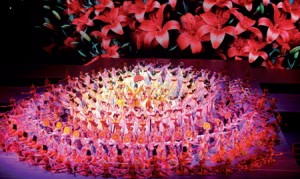Citizens of the PRC are accustomed to having reams of statistics thrown at them – indeed, contemporary Chinese rhetoric demands that any important speech begin with a recitation of numbers and percentages. The accuracy of such statistics is not taken for granted – even officials at the State Statistics Bureau have been known to advise that the stats they themselves release are best viewed as orders of magnitude.
Even so, a statistic released in early August – and circulated widely on Weibo, the popular Chinese microblog service– came so far out of the blue that it was the subject of much mirthful twittering. Calculated by Yang Yiyong, of the National Development and Reform Commission, it announced that the “Chinese national revival” was 62% complete as of 2010. (By way of comparison, it was 46% complete in 2005.) The apparent vagueness of the goal and the specificity of progress toward its attainment led to a rash of critical, often derisive commentary about the wonders of China’s “mathematical management.” Some also noted that the revival percentage roughly correlates with the number of years the Communist Party has been in power.
Indeed, the entire, quasi-religious concept of “national revival”- more often translated as “national rejuvenation” – is closely linked to the Party’s vision of itself as the Chinese people’s savior. The basic line of this “magnificent, soul-stirring epic” is best summarized by the Party History Research Center.
“The Chinese nation created a glorious civilization during its 5,000 plus year history, making outstanding contributions to the progress and development of human society. Then China went into gradual decline. After the Opium War of 1840, Western powers invaded China one after another. Having become a semi-colonial semi-feudal society, China found itself in an abyss of misery deepening by the day. To save the nation from subjugation and ensure its survival, countless people with lofty ideals desperately looked for a solution but to no avail.”
Sun Yat-sen was among those who tried to save China– the Qing Dynasty was overthrown in 1911 – but he was ultimately unable to “bring an end to China’s subjugation and humiliation and the Chinese people’s tragic circumstances.” Then, in 1921, “the Communist Party of China, a proletarian political party armed with the advanced theory of Marxism, was born in China. History put the heavy responsibility of national independence, liberation, and revitalization on the shoulders of Chinese Communists.” Things then moved quickly. “On the waste heap of old China, the Party led the people in swiftly completing the task of reviving the national economy, conducting land reform and various other democratic reforms, winning the War to Resist U.S. Aggression and Aid Korea, and advancing various tasks of new democracy.” Fast forward – past a few “mistakes” – and we are in the current “golden era.” There is still work to be done – like reviving China’s cultural power – but under the leadership of the Party, anything can be achieved. “When it comes to the Chinese nation’s great revitalization, the key is the Party and the hope lies with the Party.
To ensure that this vision of China’s revival is shared, Party propaganda organs constantly remind Chinese citizens of the great attainments made under its rule and the great difficulties it has overcome on their behalf. “The Road to Rejuvenation” is the name of a movie, a theatrical production, and a massive permanent exhibit at the National Museum of China. (An insightful review of the museum exhibit by Ian Johnson is here.) When the Party looks back at the “Road” it has traveled, there are a number of convenient blind spots in its rear view mirror – entire years, even decades, are erased because they were given over to devastating political “mistakes” like the Great Leap Forward and the Great Proletarian Cultural Revolution. But, when it looks forward, it has a very clear road map or “national revival blueprint” under which a “well-off society” will be achieved by 2020. That year, of course, is just one behind the 2021 centennial of the founding of the Party – when the “national revival” will presumably be near100% complete and a new metric will be needed for measuring continued progress under Party rule.


Leave a Reply